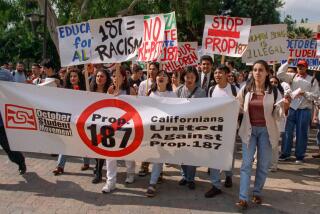FOCUS ON EMPLOYMENT : Training Is a Key in Career Strategy
Nobody said building a career would be easy. But nobody said it would be this hard either.
The year has been brutal for many Latinos and others seeking to land a first job or move up to a better one. The stateâs jobless rate hit a seven-year high in June and unemployment among Latinos was even higher--almost 10% nationwide and nearly 11% in California.
While slogging through todayâs tough times, individuals planning their careers would do well to study demographics and other trends that will affect their employment prospects and earning potential.
Economic analysts report that by the year 2000, a technology and service-oriented economy will increasingly limit higher-paying occupations to those with education and training.
This will be especially crucial for Latinos, whose importance in the labor force has just begun to be understood and whose impact is about to be felt.
By the turn of the century, Latinos will make up 10% of the nationâs work force and a third of Californiaâs workers. Hampered by a tradition of less educational attainment, a majority of Latino workers have been employed in occupations with below-average earnings, according to a U.S. Bureau of Labor Statistics study.
The bureau estimates that in the year 2000, Latinos will be at a further disadvantage in the job market unless they are better educated.
Getting a good education is not just a matter for minorities, according to Jerry Houser, director of the USC Career Development Center. âI always tell everyone--whether you have a college degree or not, keep on learning at whatever level--including adult ed and community classes, to develop new, marketable skills,â Houser said.
Understanding technology is very important in the new job market, he said. âAnd developing a specialty can help,â he added, emphasizing that this is also true for those who havenât graduated from college.
Career paths are less linear than they were a generation ago, Houser said. Young job seekers will probably experience three or four career changes over their working life and hold an average of 10 jobs. For that reason, he said, itâs important to develop two kinds of skills--specific and transferable.
Transferable skills ultimately may be as important as marketable specialties because they cut across industry booms and busts, he said. The most important of these skills is communication--the ability to write and speak well--especially to groups.
For Latinos and others, he said, bilingualism and cross-cultural ability are important transferable skills. Above all, he said, ability with English is critical. âIâve seen a lot of (educated) people busing tables and other such jobs just because they havenât got English skills. I tell international students here on campus to learn how to drop a heavy accent, and to read well and write effectively to English-speaking audiences.â
Another transferable skill for the Information Age, Houser said, is the ability to assimilate and use data. âA person who can pick up a survey and present it in an intelligent way has a place in most industries,â he said. âA little bit of math doesnât hurt,â he added, âbut you donât have to be a computer programmer.â
David Hayes-Bautista, director of the Chicano Studies Research Center at UCLA, has his own advice for Latinos seeking careers. âIâd like to say: âHey, graduate from high school and go to college,â but I wouldnât want people to think that unless they have four levels of post-graduate education they canât do anything,â he said.
One of his suggestions: Start a business. âThe service segment of the economy is growing,â Hayes-Bautista said, âand one can get involved in the business world irrespective of how much education one has.
âWhen the free-trade agreement with Mexico gets on track, there will be a tremendous growth in business opportunities and trade with Mexico,â he added.
For those interested in professions, he said, âthere is a tremendous need for more Latino health-care providers. We have gone backwards in the ratio of Latino providers to Latino population. Eleven years ago it was 1 (physician) to 4,500,â he said. âNow it is about 1 to 6,000 because of the growth in population. There is a similar need for more teachers.â
In the Los Angeles Basin, Latinos will make up an estimated 37.5% of the labor force by 2000, according to the Center for the Continuing Study of the California Economy, a private research group based in Palo Alto. Latinos already make up 37% of the countyâs residents, but much of the population is younger than 18 and has not entered the labor market.
According to UCLAâs Hayes-Bautista, co-author of âBurden of Support,â 1 in 4 Californians will be 65 or older--at or near retirement--by the year 2030, and the great majority of the senior citizens will be Anglos. In contrast, he said, Latinos will make up nearly half the stateâs population and, on the average, be nearly a generation younger.
A study of Latino labor patterns from 1940 to 1990, to be published later this year by Hayes-Bautista and two co-authors, may shed some light on the potential of the Latino labor force--and shatter some stereotypes about Latino workers, he said.
âWe found that Latinos have consistently shown the highest rate of labor force participation in California,â he said. âThey are employed more often than anyone else, are the least likely to leave the labor force, to go on welfare or receive unemployment benefits.
âThe trouble is, weâve been working the wrong jobs. Weâve been poorly paid with no benefits,â he said. âWe have to work smart --not just hard.â
David Heer, associate director of the USC Population Research Laboratory, agrees, noting that as a group, Latinos have filled less-skilled occupations.
âWhatâs been happening in the U.S. is that blue-collar workers are not keeping up with the cost of living, while skilled professionals are--if not advancing themselves. If you donât have much education, all the trends are that your wages will decline.â
In Los Angeles County in 1980, he said, 30% of the Anglo males from the ages of 18 to 44 were college graduates--contrasted with only 8% of U.S.-born males of Mexican origin. For women ages 18 to 39, the rate was 22% for Anglos and 5% for U.S.-born Mexican-Americans.
The Bureau of Labor Statistics reports that more than half of all blacks and Latinos employed in 1988 were found in three major groups: service occupations, administrative support occupations--including clerical workers--and machine operators, fabricators and laborers.
All three groups were below the national average in annual earnings. Overall employment in the operator and service groups is expected to grow less than the national average for all occupations over the next decade.
None of this surprises UCLAâs Hayes-Bautista or USC career counselor Houser, who said, âThe college graduate in the long haul makes more money, has more opportunity for job advancement and has opportunities for management as he or she gets older.â
Summing up the Latino labor picture for the 21st Century, Hayes-Bautista said: âWe need to utilize our tremendous energy in the labor force and take it to upper-level occupations. The capacity is there. We must fine-tune how people use it.â
Growing Occupations These are fasting growing occupations nationally in terms of percentage increase, from 1988 base figures to Year 2000 projections. Social service aides 51.5% Physical therapy aides 52.5% Computer system analysts 53.3% Travel agents 54.1% Financial service workers 54.8% Operations research analysts 55.4% Surgical technologists 56.4% Physical therapists 56.4% Medical secretaries 58.0% Medical records technicians 59.9% Data processing repairers 61.2% Radiologic technicians 66.0% Home health aides 67.9% Medical assistants 70.0% Paralegals 75.3% Source: U.S. Bureau of Labor Statistics
More to Read
Inside the business of entertainment
The Wide Shot brings you news, analysis and insights on everything from streaming wars to production â and what it all means for the future.
You may occasionally receive promotional content from the Los Angeles Times.










